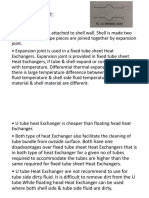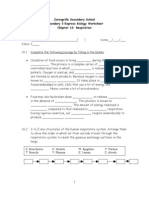Exam 1
Exam 1
Uploaded by
Abdisamad Muse HassanCopyright:
Available Formats
Exam 1
Exam 1
Uploaded by
Abdisamad Muse HassanOriginal Description:
Copyright
Available Formats
Share this document
Did you find this document useful?
Is this content inappropriate?
Copyright:
Available Formats
Exam 1
Exam 1
Uploaded by
Abdisamad Muse HassanCopyright:
Available Formats
ENGRD 221 Thermodynamics (Prof. N.
Zabaras)
Prelim 1
10/11/2007
Thursday October 11, 7:30 pm 9:30 pm Closed books and notes. Answer all questions. Make sure your answers are legible. Circle your final answer. The TAs and instructor will not respond to any questions during the exam. If you think that something is wrong with one of the problems below, please state your concern in your exam books. Problem 1 (10 points) Multiple choice questions. Answer all questions explanations are not needed and will not be graded, only provide your answer. (1) (2 points) An ideal gas is throttled to a lower pressure. During this process, (select the correct statement) (a) the temperature of the gas will increase. (b) the temperature of the gas will decrease. (c) the temperature of the gas will remain constant. (d) the entropy of the gas will decrease. (e) the enthalpy of the gas will decrease. (2) (3 points) An ideal gas process for which P vk = constant, where k=cp/cv is an (select the correct answer(s)) (a) incompressible process (d) isentropic process (b) isobaric process (e) isothermal process (c) adiabatic process
(3) (2 points) When a closed system with internal irreversibilities undergoes a process from state 1 to state 2, the entropy change, S2 S1, and entropy production, , can be a) negative and positive, respectively. b) negative and zero, respectively. c) positive and negative, respectively. d) positive and zero, respectively. e) all of the above. (4) (3 points) A refrigeration cycle operating between two reservoirs receives energy QC from a cold reservoir at TC = 250 K and rejects energy QH to a hot reservoir at TH = 300 K. If QC = 1400 kJ and Wcycle = 140 kJ, does this cycle operate reversibly, irreversibly, or is it impossible? a. b. c. Reversibly Irreversibly It is impossible
Page 1 of 4
ENGRD 221 Thermodynamics (Prof. N. Zabaras)
Prelim 1
10/11/2007
Problem 2 (5 points) 1.2 kg of liquid water initially at 15C is to be heated to 95C in a teapot equipped with a 1200 W electric heating element inside. The specific heat of water can be taken to be 4.18 kJ/kg.C, and the heat loss from the water during heating can be neglected. The time it takes to heat the water to the desired temperature is approximately: (PROVIDE ONLY YOUR ANSWER NO PARTIAL CREDIT) (a) 4.6 min (b) 5.6 min (c) 6.7 min (d) 9.0 min (e) 11.4 min
Problem 3 (5 points) Steam expands in an adiabatic turbine from 8 MPa and 450C to a pressure of 50 kPa at a rate of 1.8 kg/s. The maximum possible power output of the turbine is (PROVIDE ONLY YOUR ANSWER NO PARTIAL CREDIT) (a) 1129 kW (b) 995 kW (c) 2136 kW (d) 718 kW (e) 1791 kW
Problem 4 (5 points) Steam is compressed from 1 MPa and 280C to 8.0 MPa isentropically. Determine the final temperature of the steam. Problem 5 (15 points) Air (considered ideal gas) is contained in an insulated rigid volume at 20oC and 200 kPa. A paddle wheel inserted in the volume does 720 kJ of work on the air. If the volume is 2m3 compute the change of entropy of the system S in kJ/oK.
Problem 6 (10 points) Air (ideal gas) enters a compressor operating at steady state at 17 oC, 1 bar and exits at a pressure of 5 bar. KE and PE changes can be ignored. If there are no internal irreversibilities, evaluate the work and heat transfer in kJ/kg for an isothermal compression. Problem 7 (10 points) Two kg of superheated steam at 400oC, 600 kPa is cooled at constant P by transferring heat from a cylinder until the steam is completely condensed. The surroundings are at 25 oC. Determine the net entropy change of the universe.
Page 2 of 4
ENGRD 221 Thermodynamics (Prof. N. Zabaras) Prelim 1 10/11/2007 Problem 8 (20 points) As shown in the Fig., a steam turbine having an isentropic turbine efficiency of 90% drives an air compressor having an isentropic compressor efficiency of 85%. Steady-state operating data are provided on the figure. Determine the mass flow rate of the steam entering the turbine, in kg of steam per kg of air exiting the compressor.
Problem 9 (20 points) A tank having a volume of 0.85 m3 initially contains water as a two-phase liquid-vapor mixture at 260oC and a quality of 0.7. Saturated water vapor at 260oC is slowly withdrawn through a pressure-regulating valve at the top of the tank as energy is transferred by heat to maintain the pressure constant in the tank. This continues until the tank is filled with saturated vapor at 260oC. Determine the amount of heat transfer in kJ. Neglect all kinetic and potential energy effects. A figure is provided in the next page. Additional information:
u f (260o C ) = 1128.4kJ / Kg , ug (260o C ) = 2599.0kJ / Kg
v f (260o C ) = 1.2755 x10 3 m3 / Kg , vg (260o C ) = 0.04221m3 / Kg
hg (260o C ) = 2796.6kJ / Kg
Page 3 of 4
ENGRD 221 Thermodynamics (Prof. N. Zabaras)
Prelim 1
10/11/2007
--------------------------------------- END OF THE EXAM ---------------------------------------
Potentially useful formulas
P s = s o (T2 ) s o (T1 ) R ln 2 P 1
1 bar = 105 N/m2 R=8.314 kJ / kmol .K (universal gas constant) Molecular weight of air: M=28.97 kg/kmole q=du+Pdv, h=u+Pv, q=dh-vdP For isentropic processes of ideal gases:
dmcv = mi me dt i e
P2 P 1
pr 2 (T2 ) . pr1 (T1 )
dEcv V2 V2 = Q cv W cv + mi (hi + i + gzi ) me (he + e + gze ) 2 2 dt i e
Wcv / m | int = vdP
rev 1
Page 4 of 4
You might also like
- A Project Proposal OnDocument2 pagesA Project Proposal OnAbdisamad Muse Hassan73% (15)
- Maintenance Cat 257 b3Document238 pagesMaintenance Cat 257 b3Toufik Benamrouche100% (1)
- TD WorksheetDocument4 pagesTD WorksheetrtyiookNo ratings yet
- CHME 5101, Fall 2021: Homework Assignment 3 (Due 10/13/21, 11:59 PM US Eastern Time) Problem 1Document4 pagesCHME 5101, Fall 2021: Homework Assignment 3 (Due 10/13/21, 11:59 PM US Eastern Time) Problem 1TosinNo ratings yet
- Floor FinishesDocument100 pagesFloor Finishesflower lilyNo ratings yet
- University Online Registration System ReportDocument15 pagesUniversity Online Registration System ReportAbdisamad Muse Hassan100% (2)
- Soal PR TermodinamikaDocument10 pagesSoal PR TermodinamikaanjaniNo ratings yet
- Answer Problem Sheet-06 Me201 EntropyDocument5 pagesAnswer Problem Sheet-06 Me201 EntropyAtif IrshadNo ratings yet
- Revision SolutionDocument19 pagesRevision SolutionHassan Abo NagaNo ratings yet
- Section-1: Material-Independent Property Relations: AnswersDocument20 pagesSection-1: Material-Independent Property Relations: Answersnkosana2No ratings yet
- 10.213 Chemical Engineering Thermodynamics Spring 2002 Problem Set FDocument2 pages10.213 Chemical Engineering Thermodynamics Spring 2002 Problem Set FPM SHNo ratings yet
- Cet 8th Edition Unit 2 Solution PDFDocument78 pagesCet 8th Edition Unit 2 Solution PDFJUAN PABLO AREVALO FERNANDEZ100% (1)
- 2007 RegDocument7 pages2007 RegrajaraghuramvarmaNo ratings yet
- Homework BDocument28 pagesHomework BPravallika Kollipara0% (2)
- 05-1-Collection of Problems PDFDocument15 pages05-1-Collection of Problems PDFFistia MaulinaNo ratings yet
- Example 4Document41 pagesExample 4Akatew Haile MebrahtuNo ratings yet
- Assignment 5Document2 pagesAssignment 5Shirish MaheshwariNo ratings yet
- ME 301 HW#6 Due: Monday 3/19/2018: C C H HDocument1 pageME 301 HW#6 Due: Monday 3/19/2018: C C H HfNo ratings yet
- HW 10Document2 pagesHW 10hangman001No ratings yet
- Thermo Quiz 5Document1 pageThermo Quiz 5Jamiel CatapangNo ratings yet
- hw9 f15 SolDocument5 pageshw9 f15 SolMichael0% (1)
- Thermo 1Document2 pagesThermo 1Diwas GhimireNo ratings yet
- HW1 SolutionsDocument4 pagesHW1 SolutionsRunner ScottNo ratings yet
- Ps 1Document9 pagesPs 1Maulana ArifNo ratings yet
- Problem Sheet-03 ME201 1st LawDocument2 pagesProblem Sheet-03 ME201 1st LawPratyusha SatpathyNo ratings yet
- Thermodynamics Assignment SheetDocument3 pagesThermodynamics Assignment SheetSatwikMohantyNo ratings yet
- Sheet 2 Basic Thermo Numericals UnslolvedDocument12 pagesSheet 2 Basic Thermo Numericals UnslolvedNarendra NishadNo ratings yet
- A7 - 20-SEP-2016 - RM001 - POCE5 - Module-4-Energy Balance-NumericalsDocument17 pagesA7 - 20-SEP-2016 - RM001 - POCE5 - Module-4-Energy Balance-NumericalssantoshNo ratings yet
- Thermodynamics HomeworkDocument3 pagesThermodynamics HomeworkMinhNo ratings yet
- ME331 Thermodynamics: PS #3 Solutions: Numeric 1Document14 pagesME331 Thermodynamics: PS #3 Solutions: Numeric 1Crimson MorangeNo ratings yet
- T1 Ug 90Document6 pagesT1 Ug 90germangsilvaNo ratings yet
- Thermodynamics Exams PapersDocument23 pagesThermodynamics Exams PapersAbdul HafizNo ratings yet
- INME 4045 - Chapter 3 - Suggested ProblemsDocument2 pagesINME 4045 - Chapter 3 - Suggested ProblemsAmanda SotoNo ratings yet
- Chap4firstlawthermodynamics 130703012634 Phpapp02 141209125348 Conversion Gate02Document61 pagesChap4firstlawthermodynamics 130703012634 Phpapp02 141209125348 Conversion Gate02Abdelkader Faklani DouNo ratings yet
- Thermodynamics 19092013Document5 pagesThermodynamics 19092013hellow3533No ratings yet
- Assignment 2Document2 pagesAssignment 2Lovish ChopraNo ratings yet
- Tutorial 1 (Lecture 1-3)Document2 pagesTutorial 1 (Lecture 1-3)eja70No ratings yet
- ME 231 Montazami Whharris 10-2-18 Class Work SolutionDocument15 pagesME 231 Montazami Whharris 10-2-18 Class Work SolutionJoana ArielaNo ratings yet
- 15me03 Thermodynamics Problems June2017Document19 pages15me03 Thermodynamics Problems June2017Praveen Vijay100% (1)
- Mae 320 HW 04 SolDocument7 pagesMae 320 HW 04 SolEvan DurstNo ratings yet
- Test 1 With AnsDocument4 pagesTest 1 With AnsKavinesh GanesanNo ratings yet
- Assignment Cat 1Document2 pagesAssignment Cat 1ppraveenksrceNo ratings yet
- ME2121 Tutorial 2Document2 pagesME2121 Tutorial 2joshua_chan_10No ratings yet
- Problem Sheet 3 Heat, Work and The First Law of Thermodynamics PDFDocument4 pagesProblem Sheet 3 Heat, Work and The First Law of Thermodynamics PDFS DNo ratings yet
- Bab 2Document13 pagesBab 2Teguh Novri YansyahNo ratings yet
- P 6Document51 pagesP 6Mark Darcy UngsonNo ratings yet
- 8231 - 23984 - TD Q.Bank 14-15Document20 pages8231 - 23984 - TD Q.Bank 14-15విష్ణువర్ధన్రెడ్డిNo ratings yet
- Maae 3400: Applied Thermodynamics Problem Set 1Document4 pagesMaae 3400: Applied Thermodynamics Problem Set 1minyoun0% (1)
- 2011 MidsemDocument2 pages2011 MidsemPrashant PrabhakarNo ratings yet
- 15 C While Boiling Saturated Water at 1 Atm. What Is The PowerDocument13 pages15 C While Boiling Saturated Water at 1 Atm. What Is The PowerchurvaloooNo ratings yet
- Screenshot 2023-01-11 at 8.11.58 PMDocument15 pagesScreenshot 2023-01-11 at 8.11.58 PMAbdla DoskiNo ratings yet
- Unit Nine Homework Solutions, November 9, 2010: V V R T T C S S Const C If V V R T DT C S SDocument5 pagesUnit Nine Homework Solutions, November 9, 2010: V V R T T C S S Const C If V V R T DT C S SAbubakar AdeniNo ratings yet
- EXAM - (M) 2018: Mechanical Engineering Paper - IIDocument12 pagesEXAM - (M) 2018: Mechanical Engineering Paper - IISandeep PrajapatiNo ratings yet
- Thermo Questions 1Document4 pagesThermo Questions 1Himanshu VasisthaNo ratings yet
- Ihw 2Document6 pagesIhw 2LogoNo ratings yet
- Thermodynamics 1 Chapter 07Document162 pagesThermodynamics 1 Chapter 07Devantharan NadesanNo ratings yet
- Exergy Analysis in ThermodynamicsDocument17 pagesExergy Analysis in ThermodynamicsGerry Lou QuilesNo ratings yet
- ChE 204 HW-4 and HW-5 Together, Spring 2014, See Changes!Document5 pagesChE 204 HW-4 and HW-5 Together, Spring 2014, See Changes!Irene Kaye AceroNo ratings yet
- Tutorial 1 - QuestionsDocument5 pagesTutorial 1 - Questions2200851No ratings yet
- Tutorial - 6 - EntropyDocument7 pagesTutorial - 6 - EntropyanotherdeobiNo ratings yet
- Homework Solutions #1: C F Kelvin Rankine NotesDocument2 pagesHomework Solutions #1: C F Kelvin Rankine NotesFitriNo ratings yet
- A Modern Course in Statistical PhysicsFrom EverandA Modern Course in Statistical PhysicsRating: 3.5 out of 5 stars3.5/5 (2)
- A Project Proposal OnDocument3 pagesA Project Proposal OnAbdisamad Muse Hassan100% (2)
- Practice Set Theory ExamDocument8 pagesPractice Set Theory ExamAbdisamad Muse HassanNo ratings yet
- Ooad LabDocument30 pagesOoad LabPriya ManikandanNo ratings yet
- Practice Set Theory ExamDocument8 pagesPractice Set Theory ExamAbdisamad Muse HassanNo ratings yet
- CMSC 424 - Database Design Entity-Relationship Model Book: Chap. 1 and 6 Mihai PopDocument35 pagesCMSC 424 - Database Design Entity-Relationship Model Book: Chap. 1 and 6 Mihai PopAbdisamad Muse HassanNo ratings yet
- Aseptic BehaviorDocument5 pagesAseptic BehaviorMina Maher Mikhail50% (2)
- Krebs Unit Viscometer Model Ku-2: Digital Direct Display of Viscosity in Krebs UnitsDocument3 pagesKrebs Unit Viscometer Model Ku-2: Digital Direct Display of Viscosity in Krebs UnitsAndre Santiago100% (1)
- Design of RCC Retaining Wall at RelangiDocument18 pagesDesign of RCC Retaining Wall at RelangiD.V.Srinivasa RaoNo ratings yet
- Lampiran SE OJK Tarif Property All PDFDocument44 pagesLampiran SE OJK Tarif Property All PDFBurliansyah CoyNo ratings yet
- Environmental Arboriculture Tree Ecology and Veteran ManagementDocument15 pagesEnvironmental Arboriculture Tree Ecology and Veteran ManagementVeteran Tree Group AustraliaNo ratings yet
- The Legacy of Angkor WatDocument23 pagesThe Legacy of Angkor WatudayNo ratings yet
- 300w tp9383 PDFDocument3 pages300w tp9383 PDFlu1agp100% (1)
- M1 Helmet RestorationDocument6 pagesM1 Helmet RestorationVitor Luis Aidar dos SantosNo ratings yet
- Malunggay (Moringa Oleifera) and Malabar Spinach (Basella Alba) Extract For Reducing Salinity Level of Seawater in Watering Tomato (Lycopersicon Esculentum Mill.)Document3 pagesMalunggay (Moringa Oleifera) and Malabar Spinach (Basella Alba) Extract For Reducing Salinity Level of Seawater in Watering Tomato (Lycopersicon Esculentum Mill.)Brian KobeNo ratings yet
- Catalog Volk 2022 (S)Document36 pagesCatalog Volk 2022 (S)edyzm3104No ratings yet
- Uf Table 16wDocument1 pageUf Table 16wCarolina IskandarNo ratings yet
- Ped PPT 31Document5 pagesPed PPT 31Axit PatelNo ratings yet
- Risk Assessment For General ActivitiesDocument25 pagesRisk Assessment For General Activitiesabou bakar67% (3)
- Chapter 10 Respiration - WorksheetDocument4 pagesChapter 10 Respiration - Worksheetapi-3728508100% (5)
- DAC Requirements For ISO 17020Document25 pagesDAC Requirements For ISO 17020Steve Morrison100% (4)
- Okada Hydraulic Breaker: Demolition AttachmentsDocument4 pagesOkada Hydraulic Breaker: Demolition AttachmentsFabian BonillaNo ratings yet
- Blockchain An Exploded ViewDocument29 pagesBlockchain An Exploded ViewAira MorrNo ratings yet
- Importance of Air Distribution Between BurnersDocument2 pagesImportance of Air Distribution Between BurnersKamal Arab100% (1)
- Honeywell RM7800L1087 (Stock) 66-2028Document8 pagesHoneywell RM7800L1087 (Stock) 66-2028john kenneth vasquez vasquezNo ratings yet
- Implementation of Deadlock Avoidance Banker's AlgorithmDocument5 pagesImplementation of Deadlock Avoidance Banker's AlgorithmSmit BhenjaliyaNo ratings yet
- Entrance Test M5Document6 pagesEntrance Test M5Christopher de GuzmanNo ratings yet
- Lincoln ER 80SGDocument2 pagesLincoln ER 80SGabhishekme03No ratings yet
- Métodos para La Solución de Sistemas de Ecuaciones Lineales en JavaDocument21 pagesMétodos para La Solución de Sistemas de Ecuaciones Lineales en JavaJORGE208980% (5)
- Code Generation With t4 Text Templates IntroductionDocument23 pagesCode Generation With t4 Text Templates IntroductionvamosraghavaNo ratings yet
- ST&R Chopsaw (Rov)Document2 pagesST&R Chopsaw (Rov)魏永涛No ratings yet
- YMCA Documentation PPT G-1Document8 pagesYMCA Documentation PPT G-1shaik irshath ainNo ratings yet
- 9 5in Modular Motor - MMTR 70 01 003Document2 pages9 5in Modular Motor - MMTR 70 01 003Qiang ZhangNo ratings yet






























































































